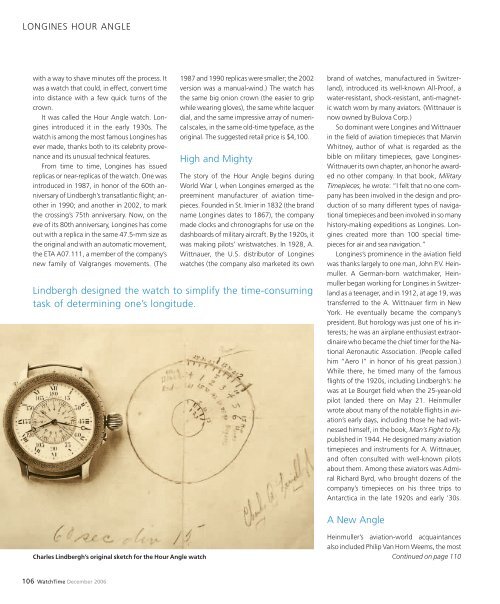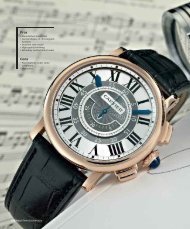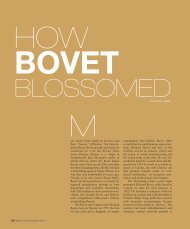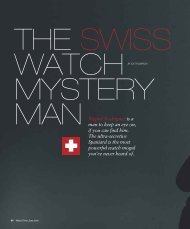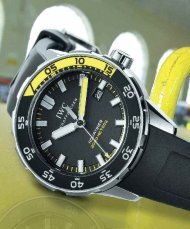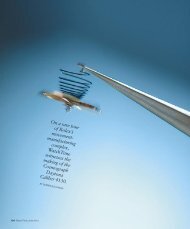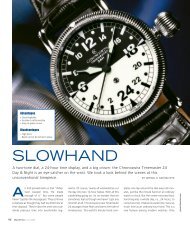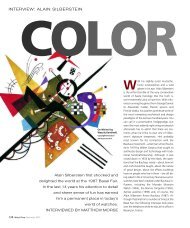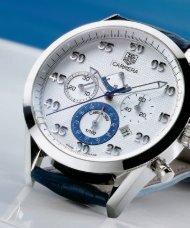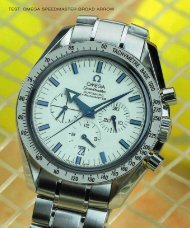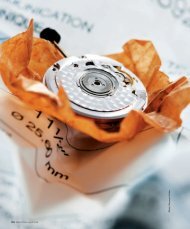WT_2006_06: LONGINES HOUR ANGLE
WT_2006_06: LONGINES HOUR ANGLE
WT_2006_06: LONGINES HOUR ANGLE
You also want an ePaper? Increase the reach of your titles
YUMPU automatically turns print PDFs into web optimized ePapers that Google loves.
<strong>LONGINES</strong> <strong>HOUR</strong> <strong>ANGLE</strong><br />
with a way to shave minutes off the process. It<br />
was a watch that could, in effect, convert time<br />
into distance with a few quick turns of the<br />
crown.<br />
It was called the Hour Angle watch. Longines<br />
introduced it in the early 1930s. The<br />
watch is among the most famous Longines has<br />
ever made, thanks both to its celebrity provenance<br />
and its unusual technical features.<br />
From time to time, Longines has issued<br />
replicas or near-replicas of the watch. One was<br />
introduced in 1987, in honor of the 60th anniversary<br />
of Lindbergh’s transatlantic flight; another<br />
in 1990; and another in 2002, to mark<br />
the crossing’s 75th anniversary. Now, on the<br />
eve of its 80th anniversary, Longines has come<br />
out with a replica in the same 47.5-mm size as<br />
the original and with an automatic movement,<br />
the ETA A07.111, a member of the company’s<br />
new family of Valgranges movements. (The<br />
1<strong>06</strong> WatchTime December <strong>20<strong>06</strong></strong><br />
1987 and 1990 replicas were smaller; the 2002<br />
version was a manual-wind.) The watch has<br />
the same big onion crown (the easier to grip<br />
while wearing gloves), the same white lacquer<br />
dial, and the same impressive array of numerical<br />
scales, in the same old-time typeface, as the<br />
original. The suggested retail price is $4,100.<br />
High and Mighty<br />
The story of the Hour Angle begins during<br />
World War I, when Longines emerged as the<br />
preeminent manufacturer of aviation timepieces.<br />
Founded in St. Imier in 1832 (the brand<br />
name Longines dates to 1867), the company<br />
made clocks and chronographs for use on the<br />
dashboards of military aircraft. By the 1920s, it<br />
was making pilots’ wristwatches. In 1928, A.<br />
Wittnauer, the U.S. distributor of Longines<br />
watches (the company also marketed its own<br />
Lindbergh designed the watch to simplify the time-consuming<br />
task of determining one’s longitude.<br />
brand of watches, manufactured in Switzerland),<br />
introduced its well-known All-Proof, a<br />
water-resistant, shock-resistant, anti-magnetic<br />
watch worn by many aviators. (Wittnauer is<br />
now owned by Bulova Corp.)<br />
So dominant were Longines and Wittnauer<br />
in the field of aviation timepieces that Marvin<br />
Whitney, author of what is regarded as the<br />
bible on military timepieces, gave Longines-<br />
Wittnauer its own chapter, an honor he awarded<br />
no other company. In that book, Military<br />
Timepieces, he wrote: “I felt that no one company<br />
has been involved in the design and production<br />
of so many different types of navigational<br />
timepieces and been involved in so many<br />
history-making expeditions as Longines. Longines<br />
created more than 100 special timepieces<br />
for air and sea navigation.”<br />
Longines’s prominence in the aviation field<br />
was thanks largely to one man, John P.V. Heinmuller.<br />
A German-born watchmaker, Heinmuller<br />
began working for Longines in Switzerland<br />
as a teenager, and in 1912, at age 19, was<br />
transferred to the A. Wittnauer firm in New<br />
York. He eventually became the company’s<br />
president. But horology was just one of his interests;<br />
he was an airplane enthusiast extraordinaire<br />
who became the chief timer for the National<br />
Aeronautic Association. (People called<br />
him “Aero I” in honor of his great passion.)<br />
While there, he timed many of the famous<br />
flights of the 1920s, including Lindbergh’s: he<br />
was at Le Bourget field when the 25-year-old<br />
pilot landed there on May 21. Heinmuller<br />
wrote about many of the notable flights in aviation’s<br />
early days, including those he had witnessed<br />
himself, in the book, Man’s Fight to Fly,<br />
published in 1944. He designed many aviation<br />
timepieces and instruments for A. Wittnauer,<br />
and often consulted with well-known pilots<br />
about them. Among these aviators was Admiral<br />
Richard Byrd, who brought dozens of the<br />
company’s timepieces on his three trips to<br />
Antarctica in the late 1920s and early ’30s.<br />
A New Angle<br />
Heinmuller’s aviation-world acquaintances<br />
also included Philip Van Horn Weems, the most<br />
Charles Lindbergh’s original sketch for the Hour Angle watch Continued on page 110


